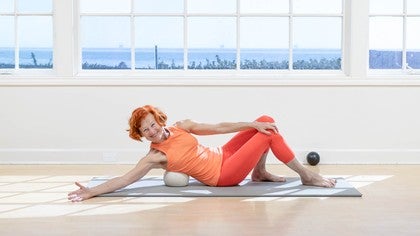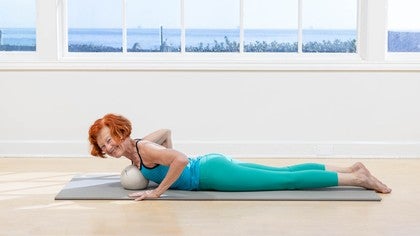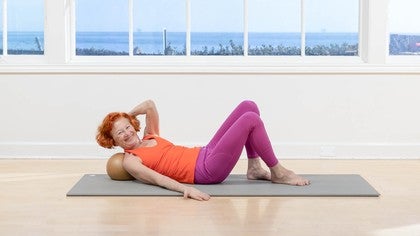Description
Props Needed: White and Black Yamuna USA® Ball or something equilvent
About This Video
Transcript
Read Full Transcript
Welcome, in today's video, we're going to be releasing the lats, the latissimus dorsi. They're the big muscles on the side of the ribs that bodybuilders like to show off but they're actually much bigger than that. They start at the base of your sacrum and they move up and out into the ribs and they attach to the arm. So it's a big triangular muscle that affects your posture, connects your lower body and your upper body. It helps broaden your ribs and allow you to breathe into your back ribs and it helps the shoulders sit properly on the spine and have your arms go up and down easily and properly.
Any kind of arched back, forward shoulders all are indicative of tight lats. So we will be starting by stimulating the sacrum. Let me demonstrate what will happen. You will work with a smaller ball that fits about the size of your own sacrum. And we will be rolling at the base, you're gonna find your tailbone and sacrum and just roll out a little bit and then roll out to stimulate and soften the bones.
That's going to be our first segment of what we'll be doing. So let's start on the back. Like to get the ball in the center of the sacrum and then lie down. At this point, all we are doing is we are stimulating the bones because they get jammed up, the muscles get tight, everything gets rigidified and starting to soften the bone is essential to maximizing the effects of what you will get as you start to move into the muscle tissue. From here, feel yourself sinking, let's take a big breath in and send the breath into the area of the sacrum and the ball.
Big breath in, as you breathe out feel yourself sinking into the ball, maybe even pressing your pelvis down and rolling. I've rolled up a bit, now I've caught my tail, so low part of the sacrum into the tail. I can feel the compression into the ball and then staying pressing in, roll slightly to the left and the ball has come to the outside. So you're stimulating the bone and the beginning of the tissue on the outside of the right side of the sacrum. Just take a moment here, take a breath in again, every time you're sending the breath into where the ball is and putting pressure into it on the output just very slightly press and rotate.
Then come back and roll to the middle of your sacrum, so you're catching the pressure down into the ball. Take a breath in. See if you can breathe that sacrum down into the ball and then on the out breath, roll your bottom to the left and you are pushing and widening the tissue to the right. Come back to the sacrum, roll a little bit further up, you're at the top of the sacrum, take a breath in, breath out, press into the ball. Remember pressure into the bones, pressure into the tissue there is going to start to wake everything up and then you roll microscopically to the left and you widen the sacrum out a bit.
So we are just getting all the attachments around there. Come back to the center of the sacrum, roll a little bit higher up and just roll a little bit further out. So you are now spanning the top of the sacrum and the top of the pelvis. We're widening it and creating pressure. We're setting the base for everything else.
Then come back, place the ball down at your tailbone again, a nice way is to take your hands and push the ball down, so you're literally tractioning your sacrum to make it long. Take a breath in, breath out and roll your bottom to the right and you're pressing into the left side and you can feel the tissue of the glute widening a little bit. Come back, roll a little bit higher up on the sacrum, so your middle of the sacrum, take a breath in. On the out breath, you press down into the ball, you're spreading and widening the bone and roll a little bit further to the left, again, tractioning the tissue there. Come back, roll a little bit further up.
You're on the left side of the sacrum on the high part of the sacrum, take a breath in. On the out breath, you are pushing down into the ball, widening a little bit out. So my bottom's moving to the right to press and widen the area. Come back, come back to the center. Take a moment here to feel what your sacrum feels like.
It usually, there is a pulse you're looking to start to get to come into the bones. Now roll a little bit further up. So now you're at the top of the sacrum, top of the pelvis, in the bony structure and widen a little bit further out. What we are doing right now is really focusing in on the boney structure to start to wake it up, decongest anything and restore certain aliveness and flexibility into the tissue, so that the rest of the muscle starts to free up and move. Then take the ball out, lie down just for a moment just check in, so important to check in every time after you've done some work and just see what you feel like.
And then roll to one side, then come up and we are going to change now and work with a slightly larger ball. This ball, this is my hand, this is the ball, you can use one of those or a slightly bigger one. It depends on your back really. You will start by placing the ball, again on the right side as low down as you can. Take a breath in and on the out breath start to put pressure into the ball.
So because it's a bigger ball, it's covering a broader surface and now we're starting to address this whole chain that will move up the back body. You want to feel your spine, your pelvis and the tissue on the right side. Take a breath in, remember you want to feel the breath expand the body where the ball is and on the out breath, really press in and listen in, 'cause there's that point where the body goes, ah and starts to open. You're looking for that in your own body. One more time, breath in, breath out, press into the ball.
This isn't really a form of like you're digging in and then moving like you're moving through molasses a little further up. So I am now riding the right side of my spine and my waist area. Take a breath in and on the out breath, you pull the stomach into the back and you feel the back pressing into the ball. I'm not relaxing, I'm compressing. So I'm not releasing that shortening the muscle, keeping the muscle long, so I can start to get that tractioning and elongation at it's more natural native state.
One more breath in, breath out. Lift your hips a little bit and roll further up. You're going to roll till you are just past your floating ribs and you are on the ribs proper. The floating ribs are the most, little bit more fragile, you can say so. As a beginner, I wouldn't recommend taking pressure into them.
Big breath in, breath out. I'll bring my arms up so you can see what's happening and I'm lengthening into the ball. And then from here, starting to roll out. So I'm rotating to the right. I'm starting to widen the ribs.
In the in breath, press the ribs into the ball. See if you can inflate in that area and expand the diaphragm into that area. Breathing out, press in, create compression in the ribs, in the muscles, in the tissue. You're widening your back. Move a little bit more to the left and start rolling.
Now I'm on the back corner of my rib cage. Take a breath in, inflate the ribs into the ball, breath out and now roll all the way out to the side. And this is a real fun place to kind of start to move your arm and you may feel where the attachments are. You may feel the connection of the pressure on the ball and the connection into the arm. So you're literally in experiential anatomy feeling how you are put together and the connections in one part and the other.
Keep rolling till you are right on the side. You want to feel that back very broad. Notice that I'm pulling this side a little bit forward to stretch out that area and have the ball create that releasing and elongation of the texture of the muscle and the fascia. Then lift up 'cause we are moving from origin to insertion, move the ball further up, so now it's in the shoulder blade, bottom shoulder blade area on the side of the spine, take a breath in, press in. You use your body weight to press, remember you're not inflating and collapsing, you are actually putting pressure straight down.
And this is one of the reasons I like a ball that's not too hard because then it talks to you and you talk to it and the breathing can press and inflate the ball as well. So take a breath in, push into the ball. So from the inside of your lungs, you're pushing into the ball and from the ground up you're pushing into the ball. So there's a lot of pressure from both sides that you're getting into and start to move your body to the left. I'm taking my arm out, so I'm spreading my shoulder blade.
So I'm on the shoulder blade and I'm aiming below the armpit. Take a breath in, inflate the ribs, press them into the ball. Imagine that you're making this whole rib cage broader and wider and more spacious and then roll even further out until you are getting onto the back corner. Now I'm on the back corner, I feel the shoulder blade. You can also move the arm a little bit.
You can possibly feel if you can feel things are pulling in tight, well you're discovering where your lats are tight and you will have much more freedom after this. and roll a little bit further to the side and just lengthen into it and take one more breath. See if you can get the ribs into the ball, really press, expand the ribs. This will give you more lung capacity, a lot of space in the lungs is often just blocked and not working and then sink into it. Let it really decompress those high tiny ribs under the armpit, lots of congestion.
Back to the spine. And this time we are at the shoulder blade area we are going to go right under the armpit. So take a breath, breath out and roll out. Now you're right in the shoulder blade, pressing into the shoulder blade, can take your arm to the side if you want. Roll a little bit further out, so now I'm catching the back of the shoulder blade and I'm beginning to move my body down and my arm up and I can start to feel the pull.
You may feel some pull kicking in, where the muscles are tight and then keep on rolling until you get right above the armpit and you're sinking into this area. Notice that I am internally rotating my hand because I want to get right where this muscle is attaching into the bone of the arm, right high up in there. So see if you can, more or less be globally in the area. Take a breath in, breath out, roll a little bit further forward to really expand this area. If you can let the ribs go down a bit you'll stretch even further and traction the lats and then come off and lie on your back and see what you feel like.
This is a real fun place. If you were in a group class, usually the right side is much longer than the left side and people look ridiculous, but just check out, how does your shoulder feel? How does the ribs in relation to the floor feel? How does your sacrum and pelvis feel in relation to the other side? Let's roll up and we will start the opposite side.
We have to even out because you probably look ridiculous now. Bring the ball right to the left side of the sacrum, nice and low, really cuddle it in there. Take a breath in, lengthen your back and then start rolling back. And as you roll back, the ball comes into the top of the pelvis and it's in the lumbar spine area. So take a moment here.
Remember it's attaching into the sacrum, all the way up the spine and then it will start spreading a lot in the ribs. So we want to stimulate this tighter area and separate it. As you're doing your time here, think of making your waist as long as you can. So you want those ribs pulled as far away from the hips as you can, lift your hips and roll up the side of the spine until you're fully on your rib cage. Take a breath in, on the out breath, start pressing into the ball, feel that compression.
Let's take another breath in and inflate the ribs right where the ball is. Feel yourself spreading out. This is an area where people get very tight and it's wonderful to start to free the adhesions up. Breathe out, and now I'm moving my body to the right and rolling a bit to the left. So again, you want to think you're widening your rib cage.
You're widening the whole lung area. You're widening the lats in order to have better posture. Take a breath in, come a little bit further to the side. So your back corner of the rib cage just before the side, big breath into the ball here. Can you inflate right there?
Can you make those ribs expand and on the out breath, roll right onto the side and just take a moment to put pressure into where this muscle attaches. Big breath and breathe out. Sink, spread the tissue. If there's anything kind of more sensitive or funny, it's nice to spend time there and start to release it. Then come on back and move the ball higher up so it is at the base of the shoulder blades on the left side.
So again, we are widening, we're making a beautiful, broad back with this work. Inhale, expand the ribs, press into the ball. As you exhale, feel that compression, use the force of your trunk to really create that deep pressure, bones, tendons, muscles and start rolling to the left. Remember the fascia, everything's sitting inside of this web and this web gets dry. And when you start this slow deep pressure, you start to undo stuck areas and then the fluids start rushing back in and an elasticity and openness starts to come back.
Big breath, breathe into the ball. As you breathe out, start to rotate. So I'm rolling over the shoulder blade area now under the armpit, I'm using my other hand to start to create more spread in the muscle. One more breath and rolling even further out onto the side. This is a fun part.
Again, if you move this arm a little bit, you can internally and externally rotate it, you can start to feel the effect of where the ball is and it's affecting your arms. A lot of people who can't get their arms over their head or lie the floor and get their hands to the floor, the lats are very tight and they think they need to pull their shoulder blades back. Not so, (laughing), then come back, move higher up. You want the ball at the middle top of the shoulder blade. We're going into the arm bone now.
So take a breath in, feel that pressure, breathing out, press in, again, that area can get very congested and start moving to the right spreading out the shoulder blade, bringing the arm to the side, keep moving to the right and start expanding the arm up. So we're aiming across the shoulder blade and we want to get into the arm bone. So take a breath every time, nice and slow. And in your own time, you are rolling down to get into the top of the arm, high up close to the armpit and just take some time here. This is where you can really feel the side ribs being stretched out.
If you internally rotate a little bit, you can get right into where the muscle is attaching. And if you bring the right side down, you can completely open the tissue up. Take one last big breath in here, reach the arm away, breathing out sinking a little bit further if your body's ready to do that, and then come off, lie on your back, check out what you feel like, you probably feel more open and check to see what your arms are like. If you take your arms over your head, they probably go a lot further than before. This is the movement that very often is so tight for people and/or their ribs hike up.
If their hands get to the floor, that's all your lats. So hopefully you can feel a freedom to this movement that you didn't have before. Let's come to sitting. So just for a minute, sit, see what your posture feels like, see what your shoulders feel like. And once again, lift your arms up over your head.
And so again, this is one of those movements that a lot of people, they just can't get up or the ribs pull. And I'm hoping by now you can feel the freedom that you released by lengthening your lats out. And now posture, just standing. Take a moment, stand in your own body, see what you feel like. Take a little walk on your mat and notice.
Notice how do your back ribs feel? How do your shoulders feel? How does your breathing feel? How does your verticality feel? It should be pleasurable and enjoyable.
So thank you very much. See you in the next video.
Release Your Fascia: Upper Body Freedom
Comments
You need to be a subscriber to post a comment.
Please Log In or Create an Account to start your free trial.


















